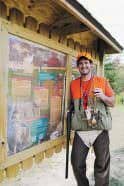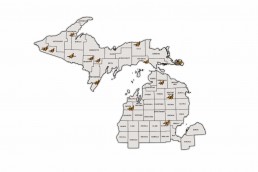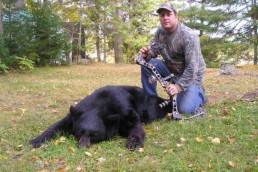GEMS are Jewels on Michigan’s Hunting Landscape
The changing leaves mark several season openers for hunters in Michigan, including September 15, opening day of ruffed grouse season.
“Opening day of grouse season is a real treat—the woods are just coming alive with color, and you can smell fall in the air,” said Al Stewart, a Michigan Department of Natural Resources (DNR) upland game bird specialist. “With woodcock season opening on September 19, we have two openers only a few days apart. This is going to be an exciting fall.”
The Michigan DNR and various partners have worked to develop and maintain Grouse Enhanced Management Sites (GEMS), which are open to public hunting. They provide new upland bird hunters with quality hunting areas, and give seasoned bird hunters new locations to explore. GEMS are located in remote areas and vary in size, from several hundred to several thousand acres.
On GEMS lands, trails are built on old logging roads, offering easy walking and helping hunters make their way without getting lost. Wildlife habitat is maintained at each area through an intensive timber harvest schedule closely monitored by the DNR. There are stations at each site with information about parking, access to trails, timber management as well as grouse and woodcock habitat.
“GEMS provide a unique experience for many people, including seniors and those with mobility challenges,” said Eric Ellis, a regional wildlife biologist with Ruffed Grouse Society and American Woodcock Society. “This year, we are providing financial support for the installation of kiosks at six GEMS locations. Also, we’ve successfully acquired grant funding and allocated Drummer Funds to further improve wildlife habitat at numerous GEMS locations.”
Ellis noted that the GEMS program creates significant parcels of young forest land, “which is great habitat for ruffed grouse, woodcock, and a host of other species including neotropical songbirds and whitetail deer.”
About GEMS
The GEMS program debuted in 2014, with seven locations.
In fall of 2015, seven additional properties will be open to public hunting. Two are in the Lower Peninsula, and five are in the Upper Peninsula, including two private property locations.
Notes: There are no “rules” with respect to how many hunters can be on a GEMS property at one time, so hunters should simply observe common-sense etiquette. Police yourselves out there, try to stay spaced out, and help each other come away with a quality experience.
At each GEMS information station, you’ll find details on discounts offered to users of the property at local businesses. “We see hunters from all over the United States making their way to northern Michigan to hunt birds,” says Stewart. “Hunters provide a great boon to local communities in the fall, and they’ll need supplies, food, gas, and lodging.”
To see local business discounts for hunters, visit this link on the GEMS website.
These are the locations for GEMS in the picture (at top).
Upper Peninsula GEMS:
- Mosinee (Gogebic County, Bessemer Township)
- Blue Bill Creek (Gogebic County, Marenisco Township)
- Hazel Swamp (Houghton County, North East Laird Township)
- Gold Mine (Iron County, Iron River Township)
- Ralph (Dickinson County, West Branch Township)
- South Marquette (Marquette County, Forsyth Township)
- Cedar River (Menominee County, Cedar River Township)
- Halifax (Luce County, McMillan Township)
- Strickler (Mackinac County, Hudson Township)
- Drummond Island (Chippewa County, Drummond Township)
Lower Peninsula GEMS:
- LeeGrande Ranch (Cheboygan County, Koehler Township)
- Greasy Creek (Montmorency County, Loud Township)
- Little Betsie (Benzie County, Colfax Township)
- Lame Duck Foot Access Area (Gladwin County, Bourret Township)
MWO
SHARE THIS POST
Did you enjoy this post?
You can be among the first to get the latest info on where to go, what to use and how to use it!
MWO
We believe being outdoors is good. With more than 1,000 articles each year, MidWest Outdoors magazine is all about sharing outdoor experiences with you—where to go, what to use and how to use it… whether you’re close to home or on that trip of a lifetime.



